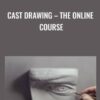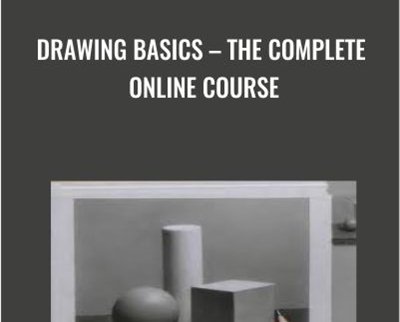$200.00 Original price was: $200.00.$55.00Current price is: $55.00.
Price Salepage: $200 -> Price for you: $59
Course: Pre-Order
Get the course after payment: 3 – 5 days.
Please contact us directly to receive payment for this course, Or Click HERE to direct payment.
 Purchase this course you will earn 55 Points worth of $5.50
Purchase this course you will earn 55 Points worth of $5.50A Drawing Course that Starts at the Very Beginning.
The ability to make beautiful drawings is the product of a well-developed skill set – a family of related abilities of the hand, the eye, and the mind, that together give an artist the tools required to draw anything. But these fundamental skills are often overlooked in introductory drawing courses and instructional DVDs, and even in art colleges, where the true “basics” are ignored – bypassed in favor of more advanced material.
But this isn’t in the best interest of students – particularly beginners. Asking someone to draw a portrait, or a figure, or a complex still life before they’ve learned to hold a pencil, draw a line, build a simple shape, or create a careful progression of values is bound to cause frustration for everyone. Too frequently, beginning students encounter the difficulty of learning to draw while attempting something inappropriately advanced and give up, deciding – prematurely – that they simply “can’t draw”, when in fact they just haven’t been shown how to develop their skills from the ground up.
Drawing Basics is our attempt to address this problem. It’s what we call a “skills course” because it focuses on fostering drawing ability through a series of exercises. The emphasis is not on producing a finished “work of art” by the end of the course, but rather on practice and repetition to develop a fundamental skill set. We assume no prior knowledge or experience in drawing, and the course proceeds sequentially, each lesson building upon what was presented previously.
What You’ll Learn in Drawing Basics – The Online Course
- A sequential method for drawing that works for drawing anything.
- Helpful exercises for developing your skills.
- Methods of measuring and sighting that help you understand the proportions of your subject and help you identify and solve problems.
- Details about the drawing materials I use and why.
- How to think about light and form and their interaction.
- How to use “squinting” to understand the value relationships on your subject and in your drawing.
- How to capture subtle curvature easily and accurately.
Here’s What You’ll Get Instant Access To:
- 10 Step-by-Step Modules containing 62 lessons with over 22 hours of video content – nearly every pencil stroke is recorded.
- Complete demonstrations of each exercise
- Diagrams and animations to illustrate key concepts
- Downloadable PDF Guides for each module.
- A thorough discussion of drawing materials and their uses
- Lifetime Access to the Course — Go At Your Own Pace
- Free Lifetime Updates.
- Question & Answer threads on each lesson page
COURSE CONTENT
Module 1 – Introduction
- 1.1 – Drawing Basics – Introduction
- 1.2 – Drawing Materials
- 1.3 – Getting Started
Module 2 – Lines
- 2.1 – Introduction to Line
- 2.2 – On Drawing Straight Lines
- 2.3 – On Gauging Angles
- 2.4 – On Drawing Curved Lines
- 2.5 – Straight Lines Exercise
- 2.6 – Gauging Angles Exercise
- 2.7 – Curved Lines Exercise
Module 3 – Shapes
- 3.1 – Introduction to Triangles Sample Lesson
- 3.2 – On Drawing Triangles
- 3.3 – Drawing Triangles: Row 1, Number 1
- 3.4 – Triangles: Row 1 Remainder
- 3.5 – Triangles: Rows 2, 3 & 4
- 3.6 – Introduction to Irregular Polygons
- 3.7 – Drawing Polygons
- 3.8 – Drawing Polygons, Part 2
- 3.9 – Introduction to Curved Shapes
- 3.10 – Drawing Curved Shapes
Module 4 – Values
- 4.1 – Introduction to Value Sample Lesson
- 4.2 – Value Compression
- 4.3 – Quantifying Value
- 4.4 – Value and Drawing Materials
- 4.5 – On the Value Scale
- 4.6 – Drawing a Value Scale
- 4.7 – Contrasts
Module 5 – Progressions
- 5.1 – Value Progressions
- 5.2 – Progression 1
- 5.3 – Progression 2
- 5.4 – Progression 3
- 5.5 – Progression 4
- 5.6 – Progression 5
- 5.7 – Progression 6
Module 6 – Cube
- 6.1 – The Logic of the Light
- 6.2 – On Linear Perspective
- 6.3 – Structuring the Cube
- 6.4 – Introduction to the "Value Study"
- 6.5 – Cube: Value Study Sample Lesson
- 6.6 – Modeling the Cube
Module 7 – Cylinder
- 7.1 – Introduction to the Cylinder
- 7.2 – Constructing the Cylinder
- 7.3 – On "Turning the Form"
- 7.4 – Light Side vs. Shadow Side
- 7.5 – Cylinder Value Study
- 7.6 – Modeling the Cylinder
Module 8 – Sphere
- 8.1 – Structure of a Sphere
- 8.2 – The Structure of the Light Mass
- 8.3 – Structuring the Sphere
- 8.4 – Sphere: Value Study
- 8.5 – Modeling the Sphere, Part 1
- 8.6 – Modeling the Sphere, Part 2
Module 9 – Arrangement of Solids
- 9.1 – Arrangement of Solids: The Envelope
- 9.2 – Arrangement of Solids: The Block-in
- 9.3 – Arrangment of Solids: Lining-in
- 9.4 – Arrangement of Solids: Value Study
- 9.5 – Arrangement of Solids: Modeling, Part 1
- 9.6 – Arrangement of Solids: Modeling, Part 2
- 9.7 – Arrangement of Solids: Modeling, Part 3
- 9.8 – Arrangement of Solids: Modeling, Part 4
- 9.9 – Arrangement of Solids: Modeling, Part 5
- 9.10 – Conclusion
Get Drawing Basics – The Complete Online Course – David Jamieson, Only Price $59
Tag: Drawing Basics – The Complete Online Course – David Jamieson Review. Drawing Basics – The Complete Online Course – David Jamieson download. Drawing Basics – The Complete Online Course – David Jamieson discount.drawing basics for kids, drawing basics for beginners, drawing basics pdf, drawing basics and video game art, drawing basics book
Only logged in customers who have purchased this product may leave a review.
Related products
= 72 Points
Uncategorized
= 30 Points
= 85 Points
Uncategorized
Proven Fall Prevention Strategies: Exercise, Meds Management and Home Modification – Trent Brown
= 40 Points
Uncategorized
= 85 Points
Uncategorized
= 85 Points
Uncategorized
= 85 Points
Uncategorized
= 35 Points





Reviews
There are no reviews yet.